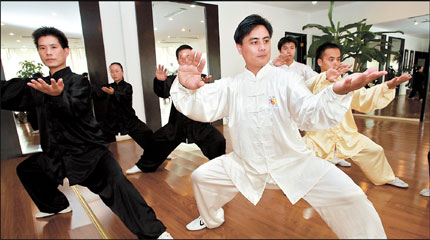Magical martial arts
 0 Comment(s)
0 Comment(s) Print
Print E-mail Shanghai Daily, June 11, 2012
E-mail Shanghai Daily, June 11, 2012
 |
|
Master Huang Zhongda (in white) guides his students in a training session of tai chi, a kind of Chinese martial arts, in Shanghai. |
That's what happens in Chinese legends, martial arts fiction and kung fu movies. These images are powerful and resonant.
Many Chinese have martial arts dreams, and a kung fu hero in their fantasy world is capable of supernatural feats, accomplishing missions impossible by directing profound nei gong (internal force) developed through rigorous physical training, rhythmic breathing exercises, concentration and meditation. They are masters of qigong and what appear to be magical martial arts techniques.
But while some techniques do exist in the real world, they are not magical and don't rise to the heights of fiction.
With roots in Chinese medicine, martial arts and philosophy, qigong is an ancient practice to cultivate and balance qi . It is known for its general health benefits, as is the soft martial art of tai chi.
Martial arts masters, however, practice for years in an effort to connect energy meridians and tap the intrinsic life force.
Qigong recently made headlines and generated controversy when medical professionals in northwest China's Gansu Province claimed last month to have successfully opened up and linked the two fundamental energy meridians, ren and du, with just nine days of training. Presumably, the health benefits would be enormous.
The head of the Gansu Health Bureau said he wanted to spread training in these techniques throughout the province.
News reports quoted some practitioners as saying they felt their kidneys burning and a sensation of boiling water in the brain when they opened up these meridians or channels. Some said their ailments were cured or much relieved.
In traditional Chinese medicine, the ren meridian (the conception vessel) and du meridian (the governor vessel) are the two important energy channels that run vertically and in parallel in the front (ren) and back (du) of the body.
In kung fu fictions, unblocking and linking the two meridians in a loop dramatically improves a martial arts practitioner's nei gong; the practitioner is infused with power and seemingly reborn into a super body.
The extravagance of these claims is why so many people are skeptical about qigong's supposedly ultimate powers.
But according to 60-year-old Jason Yao, who has practiced qigong along with various martial arts for 40 years, unblocking the two meridians isn't as magical or difficult as described in fiction. Fluent energy is quite basic in qigong practice and is helpful in health maintenance but it does not create superpowers, he tells Shanghai Daily.
A number of experts in health and science institutes and associations declined to wade into the Gansu controversy and discuss the issue of qigong powers and TCM, saying they feared misinterpretation.
"TCM holds that energy stagnation is a major trigger of ailments and disease. Thus, efficient energy circulation can surely help achieve a healthy constitution," Yao says. "But that is usually more effective as prevention and cure."
Yao says he never had magical feelings of boiling water in his brain but felt much refreshed after connecting the two meridians and achieving energy circulation through mental exercise and physical movements.
"It is understandable that people exaggerate the power of qigong since they get most of their information from fiction," says David Deng, a coach at the Shanghai Taoist Culture Kung Fu Club. "But that doesn't mean everything you heard about kung fu is fake."
According to him, qigong comprised of physical movements together with breath and energy adjustment, can significantly improve their power and speed but there's nothing magical, supernatural or superhuman about it.
Qing gong (flying skill)
In novels and movies, martial arts practitioners can take flight, soar for miles at extraordinary speed and even battle each other in the air.
The bamboo forest fight scene in "Crouching Tiger, Hidden Dragon" (2000) amazed many viewers as combatants sprang and bounded into the air, landing atop the bamboo and taking off again. They demonstrated the kung fu technique of qing gong (light force), which controls energy in and around the body.
"Flying is, of course, impossible," says coach Deng who has practiced martial arts since he was age 6. He has been practicing qigong for a dozen years. According to him, people with certain qing gong abilities can move and climb much faster than ordinary people, but no one can defy the laws of gravity and physics.
"With certain control of the breathing and energy, we can achieve faster movements and a 'lighter' body (related to flexibility, not actual body weight), which helps with climbing or jumping," Deng says. "Getting over a wall or climbing to a house beam can be easy for a kung fu practitioner; some masters can also dash across a roof and speed along a ridge of tile (as in 'Crouching Tiger, Hidden Dragon')."






Go to Forum >>0 Comment(s)